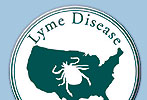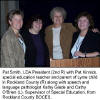

 |
 |
|
HOME | ABOUT US | AFFILIATES | CONTACT US | Doctor Referral | DONATIONS | LEGISLATION | ORDER BROCHURES |
|
|
Lyme Disease Association, Inc. |
|
|
Lyme
in the Schools
 Michelle's
Law Signed by President Bush on 10/9/08 to protect college to maintain health insurance eligibility in illness. It goes into effect on 10/9/09. Additional information During 1992−2006, a total of 248,074 cases of Lyme disease were reported to CDC by health departments in the 50 states, the District of Columbia, and U.S. territories; the annual count increased 101% (9,908-1992,19,931-2006). Incidence was highest among children aged 5−14.
Lyme Disease in New Jersey Schools The Lyme Disease Association, Inc. (LDA) has provided in-service training to NJ school districts since 1992. The LDA has been a registered Professional Development Provider for the State of NJ since the year 2000, providing development in the area of Lyme and other tick-borne diseases. LDA has a number of resource people who help develop the material which LDA uses and distributes. All materials and presentations are free. LDA (when it was LDANJ) helped to develop and pass the law which developed a state adopted curriculum for use in NJ schools and requires NJ school districts to annually in-service any staff member who has a student with Lyme disease. P.L. 18A 35-5.1-5.3 (1992) (see bottom of this page for text). Click here for more information on the issue. LDA has also provided training to a number of other state school districts. AVAILABLE NOW!
Time for Lyme Curriculum for Schools In a cooperative effort between Time for Lyme, Inc.(TFL) and school administrators, TFL created a tick-borne diseases curriculum with age-appropriate goals, activities, and measurable guidelines—one that includes tick awareness, prevention tips, proper tick removal, and the signs and symptoms of Lyme disease. This curriculum is designed for use in elementary school (grades K and 3), middle school (grade 6), and high school (grade 9).
Picture  The
Middlesex Regional Educational Services Commission (MRESC) invited the LDA
president, who is a former board of education president, to present an
in-service to non-public school nurses in Piscataway: Overview of Lyme Disease
and How It Affects School Children, December 2005. Strategies for dealing with
children with Lyme disease in the classroom were included, as were diagnosing
and treating difficulties, ticks that carry and transmit tick-borne diseases,
and prevention. Pictured are LDA President Pat Smith (L), Mark Finklestein,
Superintendent of the MRESC and a commission nurse. The
Middlesex Regional Educational Services Commission (MRESC) invited the LDA
president, who is a former board of education president, to present an
in-service to non-public school nurses in Piscataway: Overview of Lyme Disease
and How It Affects School Children, December 2005. Strategies for dealing with
children with Lyme disease in the classroom were included, as were diagnosing
and treating difficulties, ticks that carry and transmit tick-borne diseases,
and prevention. Pictured are LDA President Pat Smith (L), Mark Finklestein,
Superintendent of the MRESC and a commission nurse.
The ABC's of Lyme
Disease: Its Impact on Children & Families  Ms.
Kinnick worked with the Lyme Disease Association and the Rockland County Board
of Cooperative Educational Services to bring the program, The ABCs of Lyme
Disease: Its Impact on Children & Families to hundreds of educators from 8
school districts throughout Rockland County, NY, on November 8, 2005. County
Health officials were also present as were numerous school nurses. Dr. Brian
Fallon, Columbia University; Sandy Berenbaum, LCSW, BCD, psychotherapist; and
Al Tagliabue, MEd, Retired Student Personnel & Community Services Director of
the Jackson Township, NJ, School District and now a learning consultant, spoke
on the issues affecting school children. Pat Smith gave an overview of the
Lyme disease issue and what LDA has done for children with Lyme. Ms.
Kinnick worked with the Lyme Disease Association and the Rockland County Board
of Cooperative Educational Services to bring the program, The ABCs of Lyme
Disease: Its Impact on Children & Families to hundreds of educators from 8
school districts throughout Rockland County, NY, on November 8, 2005. County
Health officials were also present as were numerous school nurses. Dr. Brian
Fallon, Columbia University; Sandy Berenbaum, LCSW, BCD, psychotherapist; and
Al Tagliabue, MEd, Retired Student Personnel & Community Services Director of
the Jackson Township, NJ, School District and now a learning consultant, spoke
on the issues affecting school children. Pat Smith gave an overview of the
Lyme disease issue and what LDA has done for children with Lyme.
ABC's Of Lyme
Disease Current research indicates that the Lyme disease bacteria can be transmitted within hours after an infected tick attachment. Failure of parents and teachers to recognize Lyme disease early in its course can result in a child developing a chronic difficult to treat infection in the brain, eyes, joints, heart and elsewhere in the body.
School districts are
subject to budgets constraints, laws, and policies
which can often make them unfriendly to parents lost
in the maze of obtaining proper services. Here are
some tips for negotiating that maze to help children
receive the proper accommodations.
New!
Excerpts from Best Practices in School Health
manual, the section on Lyme disease, module 4.
The excerpted pieces are from interviews with Lyme Disease Association President Pat Smith. "Reprinted with permission from Best Practices in School Health, a publication of Federal News Services, Inc. For more info, please visit www.fednewsonline.com" Make Time to Look at Lyme and In-service Ideas for Lyme Disease
The
Effects of Lyme Disease on Students, Schools and School Policy by Patricia V. Smith, President, Lyme Disease Association was published in School Leader, official publication of the New Jersey School Boards Association, Sept/Oct 2004 issue. LDA has permission to post and reprint the article.
Experiences with OCD The following article is printed with permission from the NJ OC Foundation Newsletter, Spring 2007 issue. It is presented only as an example of an unusual presentation of OCD that turned out to be associated with Lyme disease. It is written by the teen patient. The LDA is not engaged in rendering medical or other professional services or advice. Seek the services of a competent physician if you have a medical problem.
Pat Smith, President of the Lyme Disease Association
(LDA) gave a presentation to various grades of a
Health class at Voorhees High School on Wednesday,
November 10, 2004. Make Time to Look at Lyme An interview with Pat Smith, BA, President, Lyme Disease Association, Inc; Member, Board of Directors, International Lyme & Associated Diseases Society (ILADS); Former President, Wall Township Board of Education, NJ; Former Chair, Governor’s Lyme Disease Advisory Council, NJ
In-service
Ideas for Lyme Disease
We spoke with Pat Smith about two areas where school nurses can use their clinical expertise and presentation skills to develop in-services on the subject of Lyme disease.
Congressional Forum Education is the key to the future. I am sure everyone in this room agrees with that statement. Yet we have in this country today a whole segment of the population who are denied access to that key. They are the lepers of the 20th century—children with Lyme disease. I speak to you now not only as a mother but also as a past 12-year member and past president of a board of education. I travel across this state as an advocate trying to help our children get the education which they deserve and so desperately seek, yet are often denied. I have seen many problems associated with educating classified children, i.e., children with learning disabilities, but rarely have I seen the degree of ignorance, and outright callous indifference I have witnessed toward children with Lyme. Education Between Jan 1, 1996 and December 31, 1997, NJ had almost 4000 newly reported cases of LD. These cases are only the ones that fit the Centers for Disease Control, CDC, criteria for surveillance. Many more people were actually diagnosed by physicians with estimates from some medical professionals indicating that the 4,000 reported cases represent only 1/10 the actual cases in NJ. NJ has traditionally ranked either third or fourth in the nation for reported LD cases, many of which are children. A Controlled Study of Cognitive Deficits in Children with Chronic Lyme Disease The Lyme Disease Association has permission from The Journal of Neuropsychiatry and Clinical Neurosciences to post the following article in its entirety. Rhode Island School Nurses Association Lyme is the most prevalent vector-borne disease in this country and the most prevalent vector-borne bacterial disease in the world. In 2002, 24,000 were reported, an increase of 35%.That figure equals about 1/10th of actual cases, thus there were 240,000 new cases in 2002.
The Lyme Disease Association
of New Jersey, now LDA, was successful in 1992 in having the following
laws adopted in New Jersey. P.L. 18A 35-5.1(1992) The Commissioner of Education, in consultation with the Commissioner of Health, shall develop curriculum guidelines for the teaching of information on the prevention of Lyme disease within the public school health curriculum. The guidelines shall emphasize disease prevention and sensitivity for victims of the disease. The Commissioner of Education shall periodically review and update the guidelines to insure that the curriculum reflects the most current information available. P.L. 18A 35-5.3(1992) The Commissioner of Education, in consultation with the Commissioner of Health, shall also provide curriculum guides for the training of all teachers who instruct students with Lyme which emphasizes the special needs and problems of students with the disease, in order to provide information about how best to teach those students. Each school district shall annually provide training to all teachers who instruct students with Lyme disease, based upon the guidelines.
Last Modified: August 29, 2009
|
Lyme Disease Association, New Jersey, Copyright 2010 - All Rights Reserved
|
|
HOME PAGE | ABOUT US | CODE OF ETHICS | CONTACT US | CREDENTIALS | DISCLAIMER & PRIVACY | MAKE A DONATION |